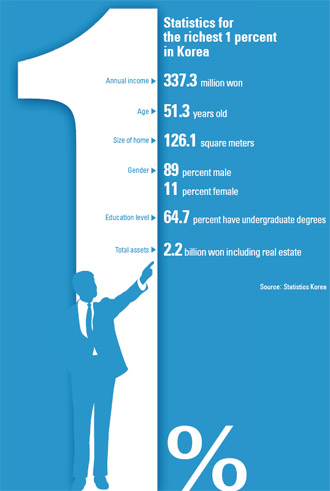Korea’s 1% under a microscope

According to a recent report released by the Korea Institute of Public Finance, the top 1 percent of income earners make 38.5 trillion won ($33.8 billion) in total per year, which is one-sixth of the country’s total income. There are 180,000 individuals belonging to this group and each person in this upper bracket earns at least 100 million won per year after tax. The report is based on an analysis of the 2006 statistics on national taxes; it is the first time for the institute to release a study on the country’s top earners.
“[Since the latest analysis is based on 2006], the minimum income of the upper one percent earners has become higher than 100 million won,” said an official from the institute.
Income disparity
According to the report, the income of this upper class group takes up 16.6 percent of Korea’s total income, which shows the country’s income distribution is highly concentrated on the wealthy.
It shows that Korea has the second-largest wealth gap among the Organization of Economic Cooperation and Development countries after the United States. The top one percent income bracket earns 16.6 percent of the country’s total income, which is slightly lower than the U.S.’s 17.7 percent.
As for the U.S., each individual belonging to the top one percent group makes more than $335,861. The third-highest is the United Kingdom with the top earners earning 14.3 percent of its total income, followed by Canada with 13.3 percent, Japan with 9.2 percent, and Australia with 8.8 percent. The percentage for Korea is significantly higher than the OECD average, which is 9.7 percent.
The 2006 report also showed that the top one percent earners in Korea paid large amounts of tax, almost 44 percent, exceeding 9 trillion won. The percentage is higher than the United Kingdom’s 24 percent and the U.S.’s 40 percent, signaling that the tax rate is higher for those rich people in Korea compared to other countries.
Who they are
The JoongAng Ilbo analyzed the 2011 household budget survey released by Statistics Korea to trace data of the individuals in the richest group by studying their living patterns. The analysis showed that they are nearly all men and aged 51.3 years old on average. They earned 337.3 million won on an annual, average basis.
They were mainly engaged in specialized jobs (32.4 percent) in fields like the medical or legal industries or in management (24.8 percent) at large companies and institutions.
The average of total assets held by each individual amounted to 2.2 billion won, of which 74 percent were from real estate. The study showed that one out of every three rich individuals in this group owns a building.
Of the assets owned by a 62-year-old former chief executive of a large company, for example, only 300 million won is in cash and the rest is real estate. He has four officetels in the Seoul area and owns a commercial building worth 800 million won.
“I earned money by investing in real estate,” he said.
The study showed that they live in apartments that are an average 126.1 square meters (1,360 square feet) in size.
“Not all doctors are rich,” said a 50-year-old surnamed Han who owns a seven-story hospital in the southwestern region of Honam in Korea. He is a successful doctor belonging to the exclusive group. “I was able to become rich because I worked harder than others.”
He said he pays billions of won in taxes every year and thinks he contributes greatly to the country by doing so.
The study showed that rich people in Korea prefer to pour their savings into banks rather than investing in funds and stocks.
More tax or less tax?
With the top earning a large percentage of the country’s income, voices have been raised from the political circle that more tax should be collected from this group. Last year, the National Assembly revised a bill to impose a 38 percent tax rate on Koreans with annual taxable income higher than 300 million won. Before the amendment, the highest tax rate was 35 percent levied on those who earned more than 88 million per year.
“It is a basic principal to levy more tax on top income earners,” said Hwang Sung-hyun, economy professor at Incheon University.
“Those in the top one percent income tier should pay more tax in this respect.”
However, there are also counterarguments, as some critics say raising the tax rate on the rich could instead decrease the volume of tax collected in total as they will seek counseling and help from tax accountants to reduce their tax payment through legal means by cutting investments.
“It is a political move to suggest raising the tax rate for the rich,” said Lee Young, an economy professor at Hanyang University. “There are no grounds for such an argument.”
By Han Ae-ran [angie@joongang.co.kr]










with the Korea JoongAng Daily
To write comments, please log in to one of the accounts.
Standards Board Policy (0/250자)